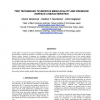149
Voted
SIAMIS
2011
2011
Local Image Features Resulting from 3-Dimensional Geometric Features, Illumination, and Movement: II
14 years 7 months ago
This is the second part of an investigation into the visual clues in illuminated scenes, in terms of the interactions between apparent contours, shade and cast shadow curves, bound...
96
Voted
MVA
1994
15 years 2 months ago
1994
The purpose of this study is to extract 3D information from 2D images passively. Though the voting technique is one of the passive methods to obtain the 3D information effectively...
131
Voted
VISUALIZATION
1992
IEEE
15 years 4 months ago
1992
IEEE
The generation of smooth surfaces from a mesh of three-dimensional data points is an important problem in geometric modeling. Apart from the pure construction of these curves and ...
101
click to vote
SIGGRAPH
2000
ACM
15 years 5 months ago
2000
ACM
We present a new set of algorithms for line-art rendering of smooth surfaces. We introduce an efficient, deterministic algorithm for finding silhouettes based on geometric duali...
105
Voted
IMR
2004
Springer
15 years 6 months ago
2004
Springer
In this paper we present two novel techniques to improve the quality of triangle surface meshes while preserving surface characteristics as much as possible. In contrast to previo...
107
click to vote
COMPGEOM
2006
ACM
15 years 6 months ago
2006
ACM
In the last decade, a great deal of work has been devoted to the elaboration of a sampling theory for smooth surfaces. The goal was to ensure a good reconstruction of a given surf...
106
click to vote
GMP
2006
IEEE
15 years 6 months ago
2006
IEEE
In geometric modeling and processing, computer graphics and computer vision, smooth surfaces are approximated by discrete triangular meshes reconstructed from sample points on the...
88
Voted
CVPR
2010
IEEE
15 years 9 months ago
2010
IEEE
This paper proposes a new stereo model which encodes the simple assumption that the scene is composed of a few, smooth surfaces. A key feature of our model is the surfacebased rep...
88
Voted
IPMI
2009
Springer
16 years 1 months ago
2009
Springer
Abstract. We propose in this work a novel variational method for computing maps between surfaces by combining informative geometric features and regularizing forces including inver...
137
Voted
ECCV
2006
Springer
16 years 2 months ago
2006
Springer
Abstract. Traditional stereo algorithms implicitly use the frontal parallel plane assumption when exploiting contextual information, since the smoothness prior biases towards const...




